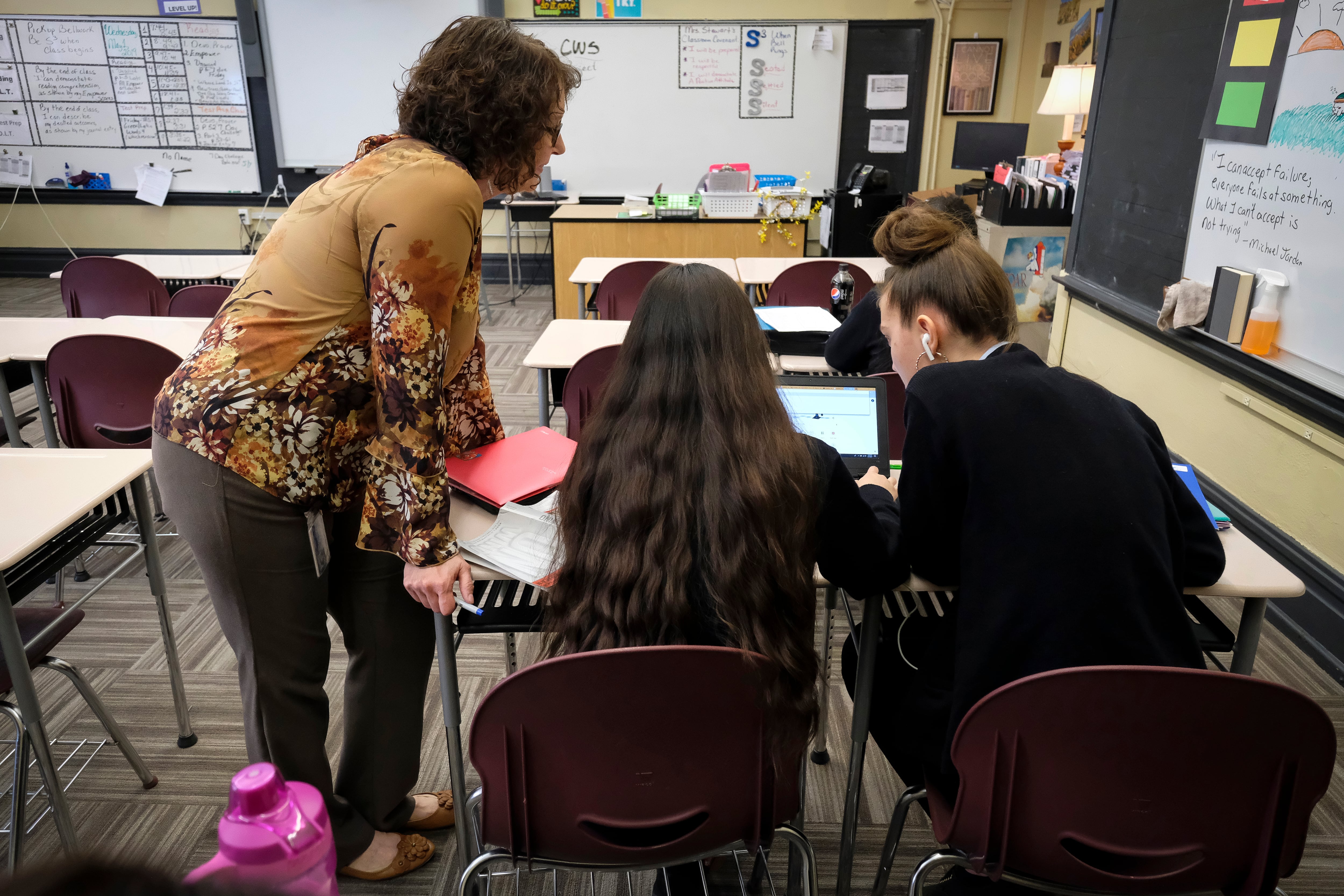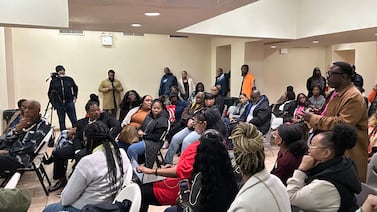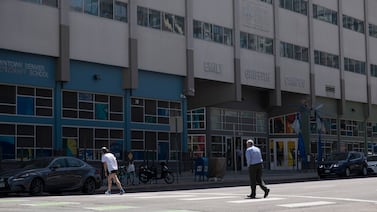Sign up for Chalkbeat Indiana’s free daily newsletter to keep up with Indianapolis Public Schools, Marion County’s township districts, and statewide education news.
Voucher use has soared in Indiana since lawmakers made nearly every student in the state eligible, with more than 90% of students at more than half of all participating schools using a voucher during the 2023-24 school year, a Chalkbeat analysis found.
That was true in just 11% of private schools before lawmakers made the Indiana Choice Scholarship available to nearly every student in Indiana by relaxing income eligibility and removing other requirements to participate in the program.
Since lawmakers approved the expansion last year, the number of schools where 100% of students receive a voucher rose from just one in 2022-23 to 28 in 2023-24. Last year, in 178 of the 349 private schools that accept vouchers, more than 90% of students enrolled used a voucher to pay for tuition.
The recent growth in the share of students using vouchers has remade the scope of Indiana’s school choice program. Instead of being limited initiatives allowing students to leave struggling public schools, it’s increasingly a means for all families to choose their preferred educational settings.
Among supporters of choice, there is disagreement about the shift. Some say it proves just how popular and justified vouchers are.
“It’s phenomenal. In some ways, it’s predictable,” said Betsy Wiley of the Institute for Quality Education, a school choice advocacy group in Indiana, about the growth in voucher use. “In the years where eligibility has been expanded, you’ve seen greater growth.”
But others worry about costs and say the program has moved too far from its original purpose.
“A few of us feel strongly that this movement is about leveling the playing field for low income kids and working class kids. There’s an argument that these are taxpayer funds and we should limit that to a purpose that’s necessary, for kids who could not make those choices without it,” said Michael Petrilli, president of the Thomas B. Fordham Institute, a conservative education policy think tank. “I do think I’ve lost that argument.”
Meanwhile, critics of vouchers say the result isn’t just that Indiana is subsidizing tuition for families who can afford it without state funds, but that the state is doing so at the expense of up to hundreds of millions in funding for public schools.
“It’s the legislature’s obligation to provide for the common school system,” said Cathy Fuentes-Rohwer of the Indiana Coalition for Public Education. “You’re taking the pie and slicing it up.”
Another big change to Indiana school choice could be coming soon. Some Republican leaders are pushing to merge the state’s three voucher tracks into one universal program that would give parents free rein over where to spend state funding.
Universal education choice through incremental expansion
Data from the state released earlier this year indicated that voucher use grew faster than enrollment, suggesting that vouchers were going to families already enrolled at private schools.
A Chalkbeat analysis comparing enrollment data to voucher use data at individual schools shows voucher use has grown at a faster rate than enrollment at the vast majority of schools. (One caveat: Many private schools have populations of just a few dozen students, meaning changes in enrollment and voucher use lead to large jumps in percentages.)
Statewide, around 70,000 students out of the 92,000 enrolled at private schools used a voucher to attend, receiving either the cost of the tuition and fees at their school, or 90% of the per-pupil funding the state gives to their local public schools — whichever is less.
More students receive a voucher worth 90% of their public school funding rather than the full cost of tuition and fees.
At only 13 schools statewide, less than half of all students received a voucher in 2023-24. Not every private school in Indiana participates in the voucher program.
Though private school enrollment has grown, it remains far below that of public schools in Indiana, which enroll over 1 million students.
The growth of the Choice Scholarship is not a surprise to critics or advocates of the program.
The state started with a small voucher pilot program and expanded it incrementally over the last 12 years. But universal access was always the program’s goal, Wiley said.
Both schools and families have driven interest in the Choice Scholarships, which supplement the financial aid package that many private schools offer, Wiley said.
Measuring performance, seeking accountability for private schools
To participate in the Choice Scholarship program, schools must administer Indiana’s statewide tests, including the ILEARN and the IREAD-3. That’s more accountability than what other states require of voucher programs, noted Petrilli.
Accredited private schools are subject to some other state regulations, like the provisions of a literacy law enacted this year that requires them — along with public and charter schools — to offer summer tutoring and to hold back third graders who don’t pass the state reading test. They also must offer the new diplomas currently in development in Indiana.
But they’re excluded from other regulations, like a new law that requires schools to create attendance plans for habitually truant students.
Data from state tests could give Indiana information about which schools should be allowed to open and accept voucher funds, Petrilli said.
Indiana used to restrict private schools’ participation in the voucher program if they consistently scored low on the state’s A-F accountability system. But those grades were essentially frozen for years starting in 2018 before they were replaced by a different system.
The Department of Education will provide the legislature with future accountability recommendations later this year, a spokesperson said.
Average ILEARN scores for the last year show that students at private schools performed better on the tests than students in public schools. But several years of broader studies of vouchers’ effects on student achievement — and other outcomes — show mixed results.
Christopher Lubienski, director of the Center for Evaluation and Education Policy at Indiana University, said his research has shown that when socioeconomic factors are controlled, public school students outperform their private school peers.
There’s likely no political will to further regulate even private schools with high voucher use, experts said. School choice advocates believe that regulations weigh down publicly governed schools, and would do the same for private schools, Lubienski said.
Moreover, as the popularity of the voucher programs grows, there may be more resistance to change or regulation.
“As they develop more intense constituencies, they develop more of a political force that can help them be shielded from transparency,” Lubienski said. “Historically, what kind of reforms last? The ones that do, they develop a constituency. … It’s not likely to disappear when you have a constituency that depends on it.”
Universal vouchers are also a centerpiece of the education plan from U.S. Sen. Mike Braun, the Republican candidate for governor.
The cost and impact of vouchers
But critics like Fuentes-Rohwer of the Indiana Coalition for Public Education say the $439 million price tag for the program in 2023-24 represented a costly diversion of public resources from public schools that the state is constitutionally obligated to fund.
According to the state’s 2023-24 voucher report, if all 70,000 students receiving vouchers had attended public schools, the state would have added over $500 million in public education funding. But most voucher students receiving vouchers have never attended a public school.
“There are so many things you have to go through as a public school system to be transparent,” Fuentes-Rohwer said. “We are very concerned that funding leaves public schools that have the obligation to educate everyone.”
With a rise in the number of schools that have a large voucher population, some predict that private schools may seek the same per-pupil funding as public schools in the future.
Lubienski noted that charter schools were once thought to be able to deliver greater achievement with less funding and regulation, but now are seeking equitable funding.
Petrilli of the Fordham Institute agreed: With less funding, charter schools ultimately couldn’t compete with traditional public schools on teacher salary.
But Wiley of the Institute for Quality Education said her group would not support a push to fund vouchers at 100% of the per-pupil cost that public schools receive. Receiving 90% of public schools’ per-pupil funding is the cost of maintaining their individuality and autonomy, she said.
She said she hopes in the next legislative session, the state removes the final requirement for the Choice Scholarship program — that families make no more than 400% of the amount needed to qualify for the free and reduced-price lunch program — in order to create a fully universal program.
“The greatest accountability for these schools is that people have to choose to go to them,” said Wiley.
Aleksandra Appleton covers Indiana education policy and writes about K-12 schools across the state. Contact her at aappleton@chalkbeat.org.
Mia Hollie is a data intern at Chalkbeat based in New York City. You can reach Mia at mhollie@civicnews.org.






